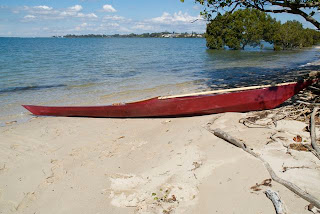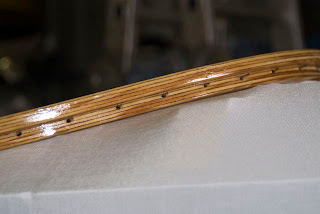There was a minor problem when I put the kayak on top of the car. Because it's a lot narrower than the other kayaks we use, it doesn't really fit the Thule Hullaport Pro carrier. It didn't feel secure enough for me, so I turned the kayak upside-down and layed it flat on the roof-rack. It actually works out well, since it means we can carry two kayaks on the roof.

Because I neglected to put any kind of handle on the stern of the kayak, there was nowhere to hang a safety flag, so I just put it up back-to-front and hung the flag (a red lanyard from the UNE zoology department) from the paddle strap on the bow.
Note the blatant plug for Redlands Kayak Tours on the sticker.

When we arrived at Thompson's Beach we were actually surprised at how high the tide was. Until I got out of the car, I was a bit worried there wasn't going to be enough beach for me to take any photos. The last time I paddled there, a couple of weeks ago, we had to carry or drag the kayaks about fifty metres to the water.



Photo shoot over, I didn't waste much time in donning my skirt and PFD and getting the boat into the water. As you can see in the next photo, I used my paddle as an outrigger to stabilise the boat as I got in. Luckily the batteries in the video camera needed charging, so there's no footage of the boat tipping the other way as I was half way in and nearly depositing me in the water.

Finally, I was afloat and in water deep enough to paddle properly. As you can see from the next picture, she sits pretty high in the water, higher than I'd expected, mainly because my 60kg weight doesn't push it down much.

What these pictures don't show is just how tippy the boat is. Let's just say it was an exciting first paddle. I've heard a lot of people say, and I agree with them, that you can get a nice stable kayak and grow out of it with experience, or get one that's a challenge to paddle, and grow into it. I'm looking forward to growing into this one, because she zips along in the water and, being so light, is pretty maneuverable as well. I don't know if that maneuverability means it won't track well, I didn't paddle it for long enough in a straight line. I do know I'm going to have fun getting used to it.



Experienced kayakers will probably look at the next photo and assume I'm turning to starboard by edging the kayak and using the paddle as a stern rudder. They'd be right about the stern rudder, but the lean to the left is my hips getting a great workout as I wobbled from side to side.

This is the first kayak I've ever paddled that I could actually pick up with one hand. When Donna put this photo on Facebook, she made me delete my comment about having the "weirdest boner right now". I can't help thinking my shadow looks like a well known statue near Newcastle in England.

Now that it's a real kayak and it's had its bum wet, it qualifies to come out of the shed and live in the garage with Tony's Nantucket.

Next time I take it out, I'll be putting a sheet of closed cell foam inside to make it easier for me to slide in and out. It'll also make it a bit easier on my ankles, since the ribs won't be sticking into them like they did today. I also need to work out how to stop the dye rubbing off onto my shirt from the inside of the coaming. It might just be a case of giving it a bit of a wash to get rid of any dye that's left. If I had any goop left I'd give it a coating of that, but I used it all up finishing the deck.









































